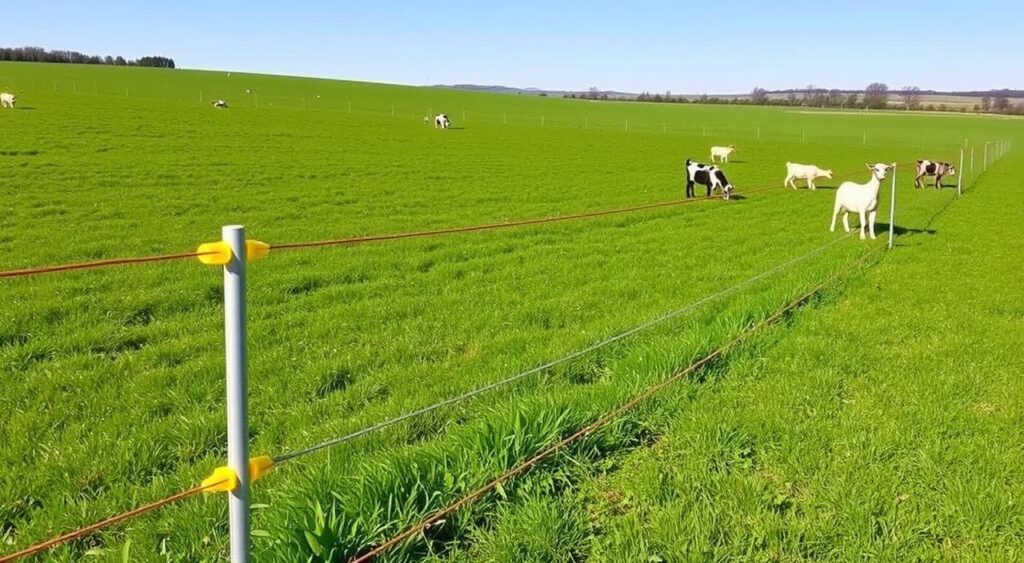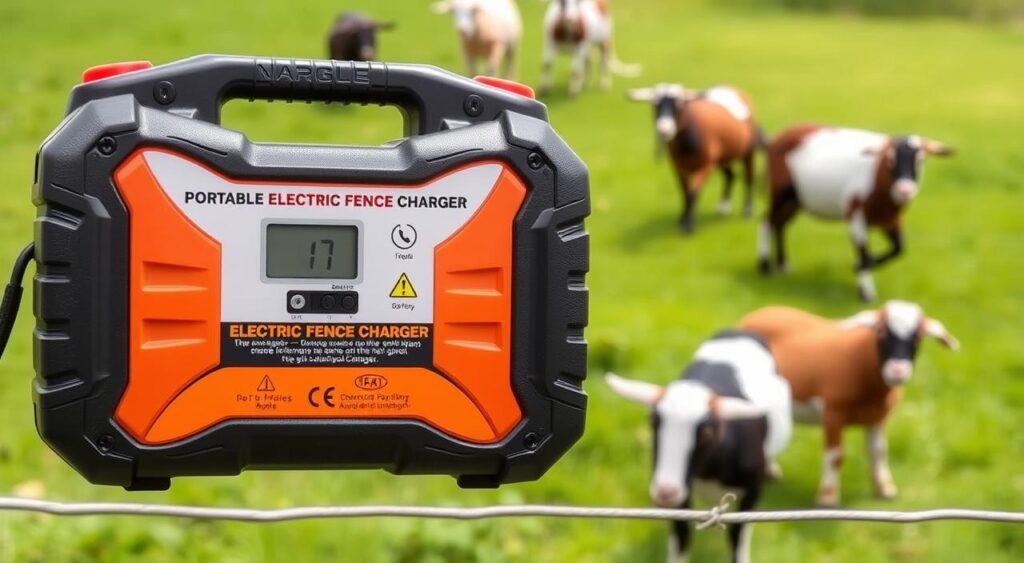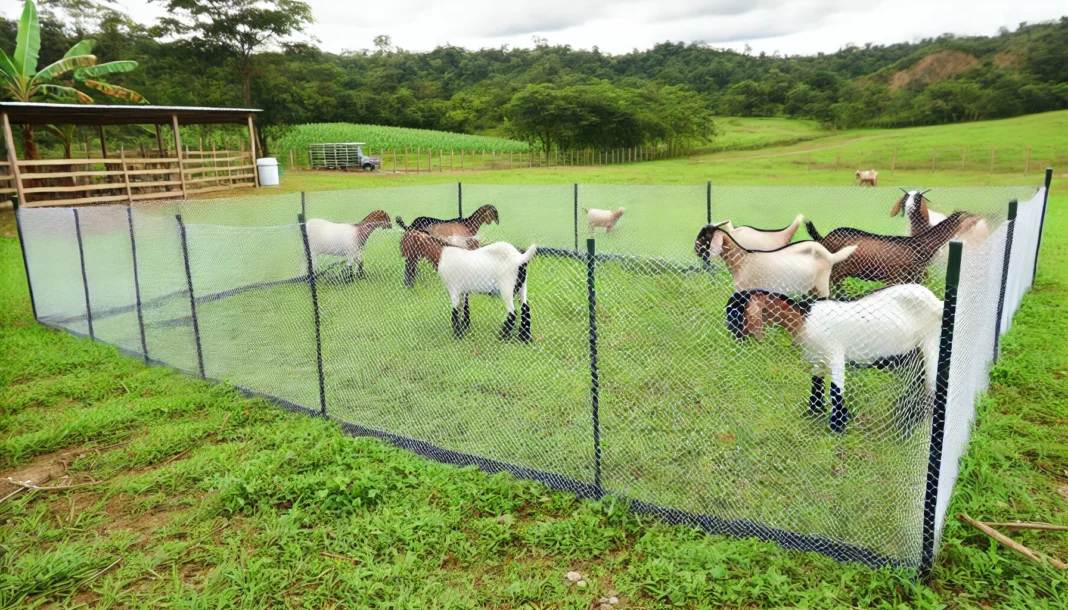Portable goat fencing with electric power is a versatile, cost-effective solution for containing your herd. It keeps goats safe while enabling easy movement to fresh pastures. This method promotes healthier grazing habits and helps regenerate soil.
Temporary Fence for Goats is ideal for rotational grazing and avoiding high costs of permanent installations. It allows quick setup of secure paddocks for your goats.
Movable goat enclosures are smart investments for owners seeking flexibility and efficiency. Options like electric netting, polywire with step-in posts, and all-in-one systems offer easy setup.
Portable electric fencing enables rotational grazing, moving goats to new pastures regularly. This practice helps control parasites and improves soil health. It ensures goats access fresh, nutrient-rich forage.
Using a goat grazing fence allows efficient herd management. It also promotes sustainable land management practices, benefiting both animals and environment.
Benefits of Portable Electric Fence for Goats
Portable electric fences offer many benefits for goat owners. They’re cost-effective, allow for rotational grazing, and provide effective containment. These fences also protect goats from predators.

Cost-Effective Solution
Portable electric fences are budget-friendly compared to permanent options. They’re easy to set up and move without expensive materials or labor. This makes them ideal for small-scale farmers or beginners in goat husbandry.
Facilitates Rotational Grazing
Rotational grazing is crucial for sustainable goat management. Portable electric fences make this practice simple to implement. Using goat fencing panels or electric netting, you can create temporary paddocks quickly.
This allows you to move goats to fresh pasture as needed. It ensures optimal nutrition for goats and promotes healthier pastures overall.
Effective Containment and Predator Protection
Well-designed portable electric fences keep goats contained and safe from predators. Goats learn to respect the fence, preventing escapes and reducing injury risks. The electric current also deters potential predators, providing extra protection for your herd.
| Fence Type | Effectiveness for Goats | Ease of Installation |
|---|---|---|
| Portable Electric Fence | High | Easy |
| Woven Wire Fence | High | Moderate |
| Barbed Wire Fence | Low | Moderate |
Portable electric fences combine effectiveness with easy installation. This makes them a top choice for many goat owners. By using this versatile solution, you’ll save money and improve grazing management.
Types of Portable Goat Fencing
Portable electric fencing offers flexible solutions for goat owners. These temporary fences help manage grazing areas efficiently. Let’s explore some popular options for your herd.
Electric Fence Netting (Electronet)
Electric fence netting is a top choice for temporary boundaries. It’s a plastic mesh fence with spike posts, ranging from 50 to 160 feet long.
This netting effectively contains goats and deters predators. Most animals can’t penetrate it after one shock. It’s proven safe for sheep, goats, and even coyotes.

For trained goats that aren’t tall or flighty, 35″ ElectroNet® works well. It’s cost-effective and easy to set up. You can move it as needed for your herd.
Multistrand Polywire with Step-In Posts
Multistrand polywire with step-in posts is another portable option. It uses 2-3 strands of lightweight, durable polywire designed for electric fencing.
Step-in posts make installation and removal quick. This setup adapts easily to changing grazing needs. It’s budget-friendly for internal sites compared to netting.
All-In-One Portable Fencing Systems
All-in-one systems like Smart Fence offer convenience for temporary goat fencing. They include a reel with four polywire strands and step-in posts.
These systems typically cover about 300 feet. You can combine multiple fences to create larger grazing areas. They’re great for subdividing existing pastures too.
| Fence Type | Recommended Use | Key Features |
|---|---|---|
| Electric Netting (Electronet) | Temporary boundary sites | Highly effective containment, deters predators |
| Multistrand Polywire | Internal sites, cost-effective option | Lightweight, durable, easy to install and remove |
| All-In-One Systems (Smart Fence) | Convenient and efficient temporary fencing | Single reel, four strands, step-in posts, expandable |
Consider your herd size, terrain, and budget when choosing portable goat fencing. Various options suit different grazing fence for goats needs. Find the best temporary pasture fence for your goat farming operation.
Pros and Cons of Different Portable Goat Fencing Options
Choosing the right portable goat fencing is crucial for your livestock’s safety. Electric netting, multistrand polywire, and all-in-one systems each have unique benefits and drawbacks. Let’s explore these options to help you make the best choice.

Electric netting offers a solid barrier, reducing escape risks for goats. However, kids might get tangled in the netting. Setting up and taking down this fencing can also lead to tangling issues.
Multistrand polywire and all-in-one systems have more open designs. This can make it easier for kids to crawl under the fence. But these options are often simpler to set up and move.
All-in-one systems boast the quickest setup times. They’re ideal for those who move their goat paddocks often. However, these systems typically come with a higher price tag.
| Fencing Type | Pros | Cons | Cost per Foot |
|---|---|---|---|
| Electric Netting |
|
| $1.70 |
| Multistrand Polywire |
|
| $0.49 |
| All-In-One Systems |
|
| $1.88 |
Your budget, goat size and breed, and fence moving frequency are key factors to consider. Weigh these against each option’s pros and cons. This will help you choose the best fencing for your goats’ safety and containment.
Essential Equipment for Portable Electric Goat Fencing
Setting up a temporary electric fence for goats requires more than just fencing material. Essential equipment ensures your portable goat fence is effective and safe. Let’s explore the key items you’ll need.

Electric Fence Charger or Energizer
An electric fence charger is the heart of your portable fencing system. It delivers a safe, pulsed electric current through the fence. This deters goats from pushing through or escaping.
When selecting a charger, consider your fence length and goat count. Also, think about the power source: battery, solar, or plug-in.
Grounding Rods and Cables
Proper grounding is crucial for an effective and safe electric goat fence. Grounding rods are driven into the soil to create a complete circuit. Grounding cables connect the fence charger to these rods.
The number of rods needed depends on your fence size and energizer power. Galvanized steel or copper are common materials for grounding rods.
| Fence Length | Minimum Number of Grounding Rods |
|---|---|
| Up to 500 feet | 1 |
| 500 to 1,000 feet | 2 |
| 1,000 to 2,000 feet | 3 |
| Over 2,000 feet | 1 additional rod per 1,000 feet |
Fence Tester and Voltmeter
A fence tester or voltmeter is vital for monitoring your portable electric goat fence. It checks voltage along the fence line, ensuring an effective shock to deter escapes.
Regular testing helps identify weak spots or areas needing repairs. This includes damaged insulators or loose connections.
Consider adding extra step-in posts for reinforcing corners and ends. Jumper cables or alligator clips can connect multiple fencing sections. Proper equipment and maintenance ensure flexible, cost-effective goat management.
Setting Up Your Temporary Fence for Goats

Installing a temporary goat fence properly ensures effective containment and animal safety. Follow these steps to set up your portable electric fence correctly. Your goats will stay secure with a well-installed fence.
Preparing the Fence Line
Clear the fence path of obstacles and vegetation before installation. Mow grass or remove tall weeds below the bottom wire or netting. This prevents grounding issues and maintains a clear boundary for your goats.
Installing Posts and Fencing
Start by installing end and corner posts, such as T-posts or other sturdy options. Unroll and set up the fencing material, like electric netting, polywire, or Smart Fence. Ensure the fencing is taut and properly attached to the posts.
| Fencing Option | Estimated Cost per 150 ft |
|---|---|
| Polywire with Step-In Posts | $0.49/foot |
| Electric Fence Netting | $1.25/foot |
| Smart Fence Setup | $1.88/foot |
Connecting the Electric Fence Charger
Connect the electric fence charger using jumper cables. Ensure a secure connection and proper grounding as recommended by the manufacturer. For best results, install three grounding rods six feet deep and ten feet apart.
Use a fence tester to confirm proper energization before letting goats into the area. Keep the fence powered on to contain goats and deter predators effectively.
A well-set temporary goat fence provides a secure, cost-effective solution for rotational grazing. Regularly inspect and maintain your fence to ensure it functions properly and keeps your goats safe.
Planning Paddock Size and Layout for Rotational Grazing
Designing goat paddocks for rotational grazing requires careful consideration of your available land. Create “L” shapes with temporary fences to set up square paddocks easily. Move goats between paddocks by adjusting the fence layout as you progress.
Paddock size depends on forage availability and herd size. Experts suggest 30,000-50,000 pounds of animals per acre daily for periodic rotations. Consider the number of animals, rotation frequency, and goats’ forage needs when determining paddock size.
Smaller paddocks promote uniform grazing. Electric fencing systems are popular for temporary goat fencing. They’re lightweight, easy to install, and adaptable. Essential tools include chargers, wire, tensioners, insulators, poly tape, and posts.
Consider the landscape when planning your layout. Goats may prefer certain grazing areas within a paddock. Account for these variations in your fencing strategies.
Water sources should be within 800 feet of any paddock point. This prevents undergrazing in distant areas. Keep this in mind when designing your water system.
| Grazing Method | Description | Benefits |
|---|---|---|
| Simple Rotation | Divides pastures into four paddocks, allowing animals to graze for a week before returning after 30 days. | Easy to implement, reduces overgrazing |
| Intensive Grazing | Involves daily moves to new paddocks with a recovery time per paddock ranging from 30-60 days, depending on climate and pasture growth. | Maximizes forage utilization, improves pasture quality |
| Mob Grazing | Livestock moved daily or multiple times a day, with paddocks resting for extended periods, sometimes up to a year. | Promotes soil health, increases plant diversity |
A well-planned rotational grazing system offers many advantages. It can reduce feed costs and improve animal health. Your goats can harvest their own forage for longer periods.
This grazing method also helps control parasites. Moving the herd to clean pastures regularly keeps them healthier. Overall, it enhances pasture quality and promotes sustainable farming practices.
Maintaining and Moving Your Temporary Goat Fence
Regular upkeep and strategic relocation of temporary goat fencing are crucial for herd health. Effective fencing solutions provide fresh pasture access while keeping goats secure. Proper seasonal care for Osmanabadi goats includes these fencing practices.
Regular Inspections and Repairs
Goats are curious animals that often test fences. Regular fence checks should be part of your routine. Look for damage like broken wires, loose posts, or electric shorts.
Fix issues quickly to prevent escapes and keep your fencing effective. This helps maintain the safety of your goat herd.
When maintaining your goat fence, keep in mind the following statistics:
- A fence height of at least 4 feet is recommended to hinder goats from jumping over it.
- Wire fencing with 4-by-4-inch small openings is recommended to prevent goats from getting their heads caught in gaps.
- For electric fencing, at least five strands of wires along the fence are suggested for effective containment.
Moving the Fence for Fresh Pasture
Temporary fencing allows you to provide goats with fresh pasture regularly. Moving the fence every 1-3 days is typical for rotational grazing. This helps reduce parasite issues and ensures access to nutrient-rich forage.
Tips when relocating your temporary fence:
- Plan your paddock size and layout to accommodate the nutritional needs of your goats.
- Ensure your goats always have enough forage in their current paddock to prevent them from attempting to escape in search of food.
- Watch for grounding issues caused by grass growth, which can reduce the effectiveness of electric fencing.
- Choose the right charger for your electric fencing to provide an adequate shock and deter goats from challenging the fence.
Regular fence relocation improves herd health and productivity. It also lowers the risk of parasites and overgrazing. Your goats will thrive with access to fresh pasture.
Where to Purchase Temporary Fence for Goats
Finding the perfect temporary goat fence retailers is easier than you might think. You can shop online or visit local farm supply stores. Both options offer a variety of livestock fencing supplies to fit your needs.
Online Retailers Specializing in Livestock Fencing
For goat fencing online, check out Premier 1 Supplies and Gallagher. They offer portable electric fencing solutions for sheep and goats. Their products cater to various herd sizes and grazing needs.
Online ordering is convenient. You can have your temporary fence delivered right to your doorstep. This saves time and effort in transport.
| Product | Price (CAD) | Rating | Number of Reviews |
|---|---|---|---|
| Gallagher S400 Portable Solar Fence Energizer (4.0 Joules) | – | 5.0 | 3 |
| Gallagher MBS800 Multi Power Fence Energizer | $749.99 | 5.0 | 1 |
| Gallagher MBS1800i Multi Power Fence Energizer | $1,258.99 | 5.0 | 4 |
| Corral Super DUO NA300 12V/110V Fence Energizer | $319.97 | – | – |
| Gallagher Reel Stand | $84.49 | – | – |
| Corral Electric Fence Gate Kit | $16.99 | – | – |
Local Farm Supply Stores
For a hands-on experience, try local farm supply stores like Tractor Supply or Wilco. They often stock portable electric fencing supplies for goats. You can see products in person and ask questions before buying.
The best part? You can take your new temporary goat fence home the same day. No waiting for shipping required.
| Product | Price (CAD) | Weight (lbs) |
|---|---|---|
| Mesh 7′ x 4’6″ Panels (Stocked Product) | $109 | – |
| Mesh 4′ Frame Gate (Stocked Product) | $134 | – |
| Heavy Duty 7’4″ by 4″ Mesh Panels (Stocked Product) | $119 | – |
| Heavy Duty 4′ Mesh Frame Gate (Stocked Product) | $179 | – |
| PVC Coated 9’6″ x 6′ Mesh Panel (Stocked Product) | $109 | – |
| PVC Coated 9’6″ x 6′ Mesh Walkthrough Panel Gate (Stocked Product) | $174 | – |
| Heavy Duty 9’6″ x 6′ Mesh Panel (Stocked Product) | $149 | – |
| Heavy Duty 9’6″ x 6′ Mesh Walkthrough Panel Gate (Stocked Product) | $189 | – |
| Light Duty 9’6″ Panel (Stocked Product) | $115 | 35 |
| Light Duty 4′ Walk-through Frame Gate (Stocked Product) | $104 | 45 |
| Light Duty 9’6″ Walk-through Panel Gate (Stocked Product) | $159 | 50 |
Choose the best place to buy your temporary goat fence based on your preferences. Compare options and prices from online retailers and local stores. This way, you’ll find the perfect solution for your herd and budget.
Training Your Goats to Respect Electric Fencing

Electric fencing works well for goats, but they need training to respect it. Goats typically require more hot wires and time to learn than cattle. Sheep fall between cattle and goats in their response to hot wire fences.
Start by leading goats around the fence line to familiarize them. Curious goats will often touch the fence and get shocked on their noses. This quick lesson usually teaches them to stay away.
Stubborn goats may need higher voltage at first. Use quality polywire that carries enough current. An efficient dual-purpose charger for AC and solar panel use is crucial.
| Training Method | Effectiveness |
|---|---|
| Leading goats around the fence perimeter | Helps goats learn the fence line and avoid it |
| Letting goats investigate and receive a shock on the nose | Teaches goats to stay away from the fence |
| Using a higher voltage initially for stubborn goats | Ensures effective training for more challenging goats |
| Monitoring goats for 1-2 hours post-training | Prevents entanglement and reinforces fence respect |
Patience and consistency are key for successful hot wire training. Once trained, goats usually respect even lower voltages. Visual barriers like flags can help reinforce the boundary.
Providing enough food and water inside the fence reduces the chance of goats challenging it. After proper training, even a single knee-high wire can contain many animals.
Goats often stay away after just one or two shocks. Watch your goats for a couple of hours after training. This ensures they don’t get tangled in the electric fence.
Conclusion
Temporary goat fences offer many benefits for owners seeking flexibility and cost-effectiveness. They adapt easily to changing grazing needs and provide effective containment. These portable fences also protect goats from predators while allowing efficient grazing management.
When choosing fencing, consider durability, ease of installation, and suitability for your breed. Electric netting, polywire with step-in posts, and all-in-one systems offer unique advantages. Proper installation, including secure grounding and adequate voltage, is crucial for success.
Training goats to respect electric fences is vital for effective containment. Invest time in this process to minimize escape risks. Regular maintenance of your portable fencing ensures its effectiveness.
With the right temporary fence solution, you can confidently manage your goats’ grazing needs. This approach optimizes their health and productivity. Choose a fencing option that suits your herd’s size, breed, and environment for best results.




